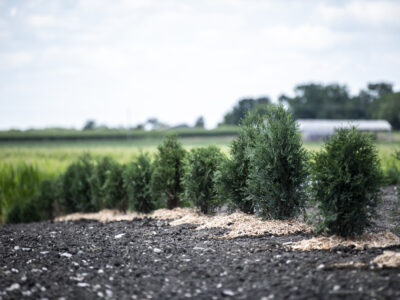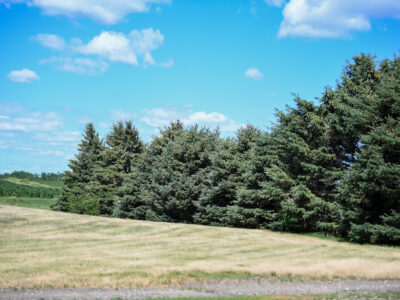Windbreaks play an important role in the protection of livestock, particularly in young animals and in areas with cold northerly winds during the winter and early spring. Properly placed windbreaks can provide benefits to feedlots, livestock pastures, and calving areas. Reducing wind speed in winter lowers animal stress, improves animal health, and increases feeding efficiency. Livestock windbreaks provide significant amounts of wildlife habitat, protect the working environment in and around the livestock area, and screen noise and odors associated with livestock operations.
Specific needs of animals dictate that special attention be given to access, snow storage, and drainage when planning a livestock windbreak. Each windbreak should be designed to meet the specific livestock operation. A well-thought-out and properly cared for windbreak protects livestock in both the winter and summer and will provide economic benefits to the landowner over the long term. The time spent on layout, site preparation, weed control, and replanting is paid back many times throughout the life of a windbreak.
Winter Protection
All warm-blooded animals must maintain their body temperatures within a relative narrow range or comfort zone. When air temperature falls below this range the animal must expend energy to keep warm. As winter approaches, many animals develop winter coats as insulation against the cold. In the case of beef cattle, a heavy winter coat will provide protection against temperatures as low as 18 degrees (Table 1). At temperatures below 18 degrees the animal is stressed and begins to require additional feed in order to maintain body temperature. Exposure to winter winds will increase the need for additional feed. If the temperature reaches zero degrees and wind speed is 25 mph, the windchill is 44 degrees below zero (Table 2). Under these extreme stress conditions, animals require significantly more feed, are less efficient at converting this feed into energy, and are more susceptible to latent diseases or other health problems. In contrast, when windbreaks are present, the reduced wind speed in the protected zone reduces the windchill temperature to 15 degrees below zero. While some danger remains for young or newborn animals, danger to mature animals is greatly reduced.
Table 1. Critical temperatures for beef cattle are determined in part by the condition of the coat. Below the critical temperature, livestock must expend more energy in order to keep warm.
Kansas cattle producers indicate, that on average, calving success increases by 2 percent if cows are protected by a windbreak. Canadian researchers found that cattle on winter range, in unprotected sites, required a 50 percent increase in feed for normal activities. An additional 20 percent increase was necessary to overcome the direct effects of exposure to a combination of cold temperatures and wind. Wind protection reduced these needs by half.
The amount of feed required to maintain body temperature in cattle is reduced when they are protected by windbreaks. For example, an 880-pound animal, with its winter coat, has a critical temperature of 32 degrees (Table 1) and requires 1.1 percent more feed per degree of cold (Table 3). If the temperature is 10 degrees and the wind speed is 10 miles per hour, the windchill temperature is 9 degrees below zero (Table 2) and the animal needs 45 percent more feed (critical temperature minus windchill temperature times increased feed requirement). If this same animal were protected by a windbreak providing a 70 percent reduction in wind speed, the windchill factor would change from minus 9 degrees to 2 degrees above zero. The degrees of cold would be 30 and the increase feed requirement would be only 33 percent, a savings of 12 percent. Colder temperatures or higher wind speeds would result in larger savings due to windbreak protection.
Table 2. Animal windchill chart. As temperatures decrease and wind speed increases the danger to animals becomes greater.
Researchers at Purdue University found that energy requirements for cows in good condition increased 13 percent for each 10 degree drop in windchill temperature below 30 degrees. A similar study in Iowa on calves and yearlings indicated that requirements for feed were 7 percent greater for those in open lots than for similar animals with shelter.
Studies in Montana indicated that during mild winters, beef cattle sheltered by windbreaks gained an average of 34 to 35 pounds more than cattle in an open feedlot. During severe winters, cattle in feedlots protected from the wind, maintained 10.6 more pounds than cattle in unprotected lots.
Other types of livestock also benefit from shelter. Milk production in Holstein and Jersey dairy cattle declines at air temperatures below 35 degrees. The amount of decline is dependent on animal health, coat condition, and feed intake. Under windy conditions further declines in production or increased feed requirements can be expected, due to lower windchill temperatures.
Swine are poorly adapted to cold temperatures and when raised in open confinement in northern areas are subject to serious temperature stress. Windbreak protection provides significant benefits to producers in reduced feed requirements, increased weight gains, and improved animal health. When raised in confinement buildings with controlled temperatures, windbreaks reduce the amount of energy necessary to heat the confinement building.
Sheep are naturally adapted to cold climates and generally receive little benefit from shelter. Two exceptions are worth noting. During severe blizzards, in areas with little natural cover, windbreaks provide valuable protection for the flock. Newborn lambs are especially vulnerable to cold temperatures and suffer significant mortality under cold, windy conditions. Providing wind protection can significantly reduce these losses…
Snow control
Optimum snow control allows easy access to animals, buildings, and forage and grain storage facilities during the winter months. Windbreaks are an effective tool which aid in protecting these travel lanes. A well designed windbreak system will collect snow in low-use areas and keep it out of high-use areas. This saves on fuel expense, reduces wear on equipment, and saves on the amount of labor required for snow removal and livestock feeding…
Summer Protection
If a windbreak is designed properly, it can protect livestock from cold winter winds and still allow summer winds to circulate in the feedlot or pasture area, reducing potential heat stress to the animals. In the North Central region where winter protection of livestock is most critical, northerly winds predominate during the winter and early spring. Locating windbreaks on the north and west sides of livestock operations provides winter protection on the south and east sides of the windbreak system. In contrast, summer winds are generally southerly, and since wind speed reductions on the windward side of windbreaks (the side towards the wind) are limited, livestock benefit from the southerly winds.
By locating feed bunks 75 to 125 feet south of the inside row of the windbreak you avoid both winter and summer problems. In the winter, the access road and feeding apron will be located beyond the area where snow will accumulate. In the summer, cattle will rarely experience significant heat stress since they are outside the area of significant wind speed reduction…
Working Environment
Windbreaks improve the working environment around feedlots, barns, and pasture areas. In the summer, windbreaks provide shade and guide summer breezes to minimize heat stress. In the winter, windbreaks reduce heat loss from barns and block cold winds.
People are even more sensitive to windchill than livestock. When wind speeds of 20 mph are combined with an air temperature of 10 degrees, it feels like 24 degrees below zero. More seriously, a temperature of minus 20 degrees combined with a wind speed of 20 mph equals a windchill of minus 67 degrees, cold enough to freeze exposed flesh in less than a minute, making outside work more difficult and dangerous. A moderately dense windbreak will reduce the 20 mph wind to approximately 5 mph out to a distance of 5H (H = effective height of the windbreak), and wind chill to minus 26 degrees, still very cold but not nearly as dangerous.
Screen Unsightly Areas
Windbreaks can screen unsightly areas around the farm from the road and living area. They filter dust from tillage operations or roads and buffer traffic or machinery noise. Some odors are absorbed by plants within the windbreak while others are masked by the more desirable smells of aromatic leaves or flowering shrubs. Conifers not only provide good wind protection, but add winter color to the farmstead….
Designing Your Windbreak
Windbreaks can be designed to protect a feedlot, pasture, or forage production area. They should be located perpendicular to the prevailing winter winds (Figure 4). For example, in the Upper Midwest and Northern Great Plains, windbreaks should be located on the north and west. In some situations, an additional windbreak on the south side will provide protection from snow storms in late winter and early spring. Be careful that windbreaks located on the south side do not block summer breezes, increasing heat stress. In southern locations, windbreaks on the south should be avoided.
Proper drainage for melting snow must be provided in order to reduce the level of mud in feedlot areas. Likewise, runoff from the feedlot should be directed away from the trees since the high nitrate levels of the runoff will damage the windbreak.
There are two major types of windbreak designs generally used for livestock confinement areas: the traditional multi-row design and a newer twin-row, high-density design. Which design you choose depends on the area available for planting, the area to be protected, and what the windbreak is supposed to accomplish (Figure 6).
The length, height, and density of a windbreak determine the area that is protected. In general, the protection provided by a moderately dense windbreak (60 to 80 percent density) will extend downwind a distance of 15H, where H equals the height of the windbreak (Figure 5).
Figure 6. Cross-section of a feedlot windbreak designed for wind and snow protection. The distance between the area needing protection and the windward row varies with the amount of space needed for snow storage. A. Traditional multi-row windbreak with a trip-row of shrubs on the windward side. B. Modified twin-row, high-density windbreak.
A windbreak designed to protect livestock must take into account a number of different factors and should be designed to meet the specific needs of the site, the farm operation, and the land owner’s preferences. The complexity increases when additional benefits or objectives are involved. For help in designing a livestock windbreak or for further information on other types of windbreaks, contact your local Cooperative Extension office, the Soil Conservation Service or State Forestry agency.



